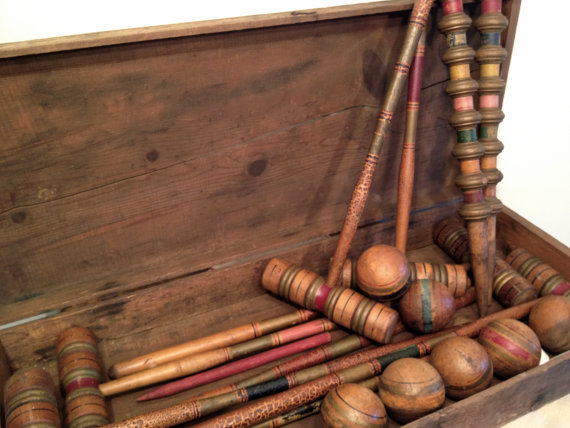The history of Croquet started somewhere in Ireland, moved to England and eventually found it's way to the US. At first, Croquet was more of a women's game, but men being what they are found that they could tweak the game to make it more manly. Croquet was also a game where both women and men could play together.
When looking for antique croquet sets, look at the croquet posts. Usually the older sets have more ornate croquet posts. Balls in general are made from wood. The mallets will also be made of wood. The mallet heads tend to have more detail than today's mallets. Older sets coming from England will usually be older and worth more.
Really nice mallets can sell for $80-$200. Post can actually sell for even more and are often used in Folk art. Don't pay more than $5 for balls, if you intend to sell them. The set below was purchased for $235 and I simply had to jump on it. A collector would probably buy it for $500-$1000.
Jacks London is one of the higher end Croquet manufactures. Their history runs long and deep. The Croquet inventor (At least in England) was John Jaques II. He won a place in sporting history and
a Gold Medal (still in the families possession) for
introducing Croquet to England at the Great Exhibition in 1851. It was especially popular in India, reportedly played by The Viceroy
himself with a solid ivory mallet, made by Jaques as part of their
finest set. Jaques still do repairs if needed at the Jaques HQ in Edenbridge.
In England the metal Wickets are called Hoops. Hoops will generally come in sets of 6, being the number on a standard croquet lawn. One hoop (the first) will be marked with a blue top, and one (the last) with a red top. The four other hoops are typically white. The regulations for hoops say that they should have uprights which are 5/8" diameter, a gap which is between 4" and 3¾" wide, and the crown of the hoop should be 12" above the ground. In practice, for clubs and tournaments, the gap of the hoop is normally set to the diameter of the balls in use, with a clearance of between 1/16" and 3/16".
If the lawn to be used is of the usual rough back lawn nature, then choosing hoops which are 4" wide may well be a good idea for casual garden play. The more serious player, and particularly on a higher quality lawn, may want to go for a tighter hoop width, more like 3¾"
You may not have know this, but Croquet was also popular as an indoor game. Of course much smaller mallets and balls were used.
When buying on line, make sure you know which Croquet type is being offered, namely the outdoor version or the indoor version.
Below is a fantastic croquet set I picked up off of Esty. It has some amazing victorian style posts, with great looking clubs. The Croquet set was probably made between 1900-1930s. The balls are made out of wood. The set was found in found in Sun Valley Idaho probably at an estate sale.
Here are some links to some newer Croquet sets
Teak Croquet Set
I really like the look of this Teak Croquet Set. It retails for $735. It was created in 2008 combines smart design and quality
construction to create a modern interpretation of the classic lawn game.
A collaboration between designers Hans Thyge and Akiko Kuwahata, this
set packs efficiently into the included teak box, providing compact
storage when the game’s not in use. The box has an integrated handle for
easy transport and is compact enough to be thrown in the car and taken
to the park. The set
consists of four mallets, four balls, 10 hoops and two pegs, and should
be played on grass.






No comments:
Post a Comment